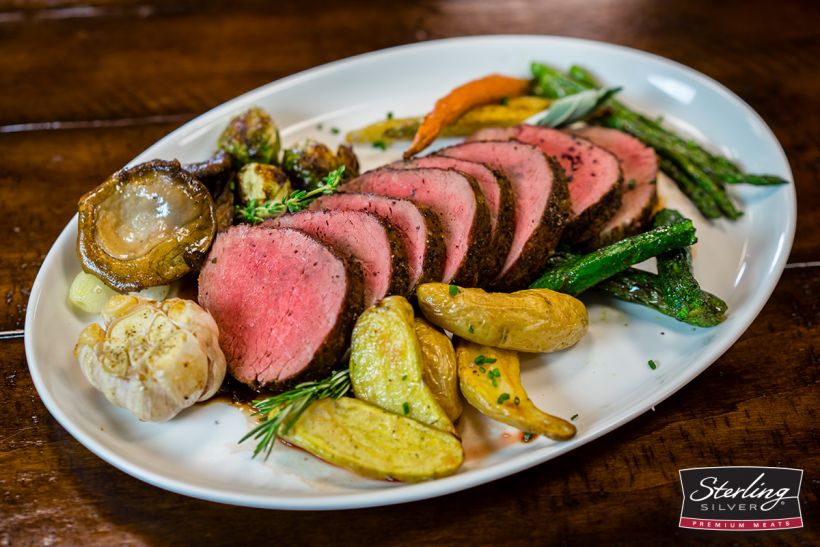Introduction
Chateaubriand is a name that brings to mind more than a cut of beef—gourmet delicacy, historic culinary dish, and tribute to French cuisine mastership. Globally, Chateaubriand is basked in the limelight of the best restaurants and gourmet dinner platters. This ancient method has stood the test of time, securing its place in the culinary hall of fame.
What is Chateaubriand? The Epitome of French Beef Excellence
The Chateaubriand is really a thick cut taken from the center of the beef tenderloin, the most prized and tender of the animal’s parts. It is usually roasted and served with a sauce rich in flavor—the most traditional options being béarnaise or red wine reduction. The meal came to be named after François-René de Chateaubriand, a French author and diplomat, after his personal chef first cooked the meal for him early in the 19th century.
In contrast to all other meat forms, the Chateaubriand is not characterized by the animal’s anatomy but by the style of preparation and service, so that it is transformed into an experience and not merely a meal.
A Historical Perspective: Noble Origins of Chateaubriand
The legacy of Chateaubriand begins in the aristocratic kitchens of 1800s France. François-René de Chateaubriand was a nobleman and gourmand whose influence extended far beyond literature. His personal chef, Montmireil, created a luxurious preparation involving a thick-cut tenderloin roasted between two thinner cuts to retain moisture and flavor. Over time, this evolved into the refined, center-cut tenderloin we know today.
The recipe traveled across Europe, and the chefs followed the method, and it became a common recipe for haute cuisine. Chateaubriand is still synonymous with perfection, luxury, and rarity.
The Cut Explained: Anatomy of the Chateaubriand
Chateaubriand is taken from the center portion of the beef tenderloin weighing around 350 to 500 grams and perfect for two servings. It’s famous for being buttery textured, with very fine grain and low in fat compared to other premium cuts such as ribeye or striploin.
Location: Center-cut of the tenderloin, between tail and filet mignon.
Texture: Extremely tender because very little muscle is used.
Marbling: Less marbled than ribeye, but far more flavorful when well-cooked.
The quality of the cut requires exact cooking techniques to bring out its subtle nature without losing juiciness or taste.
How to Cook Chateaubriand: A Lesson in Perfection
Chateaubriand preparation is both science and art. Temperature, timing, and technique must be paid attention to in order to produce the perfect medium-rare center with a crusty exterior. A step-by-step approach will result in restaurant-quality dining at home:
- Ingredients:
400g beef tenderloin, center cut - Sea salt and fresh pepper
- 2 tbsp olive oil or clarified butter
- 2 sprigs thyme
- 2 sprigs rosemary
- 3 garlic cloves, crushed
- 1 tbsp unsalted butter
Instructions:
Preparation: Let the beef rest at room temperature for 30–45 minutes. Season with ample salt and pepper.
Sear: Heat oil in a cast-iron pan over high heat. Sear all sides to golden brown (approximately 2–3 minutes per side).
Roast: Put skillet in a preheated oven (200°C/390°F). Roast for 12–15 minutes for medium-rare.
Baste: Halfway through, baste with butter, herbs, and garlic.
Rest: Allow the meat to rest for 10 minutes under foil to redistribute juices.
Serve with classic béarnaise, red wine demi-glace, or herbed compound butter.
Perfect Pairings: Sauces and Sides for Chateaubriand
A dish this refined should have a retinue of equally noble accompaniments. These are the best pairings:
Sauces:
Béarnaise Sauce – White wine vinegar reduction, shallots, tarragon, and egg yolks.
Red Wine Demi-Glace – Strongly, umami-rich flavors and appropriate for meat enthusiasts.
Peppercorn Sauce – Creamy and spicy, with ground black peppercorns.
Side Dishes:
Pommes Anna or Gratin Dauphinois – Creamy, buttery layers of potatoes.
Haricots Verts with Almonds – Green beans in French style with crunchy almonds.
Roasted Baby Carrots in Honey Glaze – Earthy sweetness in contrast to the beef.
Wine Pairing:
A robust red wine is the perfect pairing. Choose:
- Bordeaux
- Cabernet Sauvignon
- Malbec
Their aggressive tannins cut through the richness of the meat and bring out its natural flavors.
Modern Interpretations: Chateaubriand in Modern Cuisine
Although the original preparation is still greatly esteemed, Chateaubriand has been reinterpreted by modern chefs in the following manners:
Sous-vide Chatea ubriand – Seared to perfection everywhere.
Smoked Chatea ubriand – Added a light wood-fired taste.
Truffle butter finish – Indulges in earthy excess.
Garnishes can include microgreens, truffle shavings, or edible flowers, a display of fine-dining presentation.
Why Chateaubriand Is the Gold Standard for Fine Dining
Presentation: Often carved tableside for extra dramatic flair.
Texture: Unmatched tenderness with melt-in-mouth texture.
Tradition: Conveys over 200 years of culinary honor.
Versatility: Glides seamlessly into traditional and contemporary techniques.
In fine dining, Chatea ubriand is a show of taste and sophistication. Being on the menu is a promise of quality.
Purchasing the Ideal Chateaubriand Cut
To have a chance to sample this entree at its finest, shop at a high-end butcher shop or meat specialty store. For:
Center-cut tenderloin, trimmed and sanitized
Dry-aged beef, which concentrates flavor
Grass-fed for richer taste profile
Pro Tip: Request the butcher to cut a Chatea ubriand for two off the center of the tenderloin for best results.
Chateaubriand Worldwide: An International Fine-Dining Icon
From Paris’s Michelin-starred restaurants to New York’s upscale steakhouses, Chateaubriand glows as brightly as ever.
In France, they’re typically served with pommes soufflées and béarnaise.
In Japan, Wagyu Chateaubriand is renowned for its stunning marbling and fragility.
In America, it’s frequently used in holiday dinners and upscale dining rooms.
Conclusion:
Chateaubriand is the essence of beef cooking, wherein technique meets tradition, and flavor is balanced with finesse. It’s a culinary dish most deserving to be enjoyed in the haute cuisine ambiance of a luxury restaurant or prepared at home with devotion.
